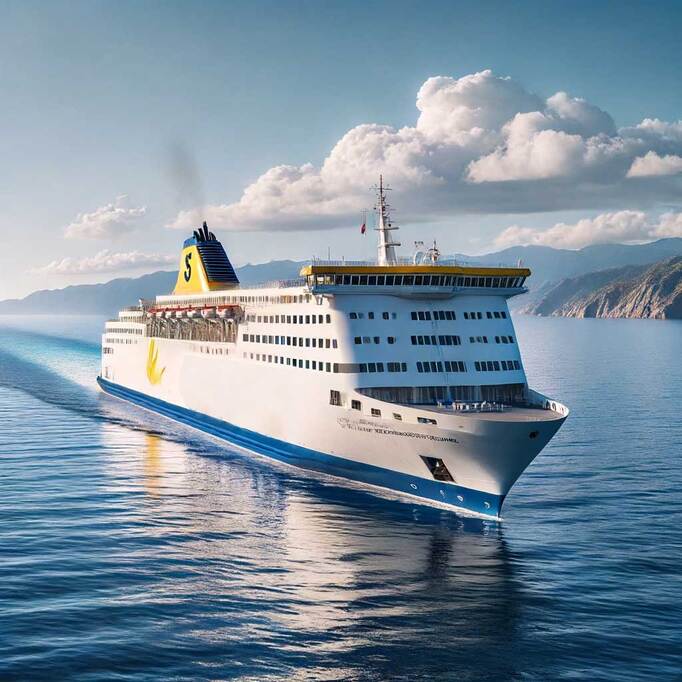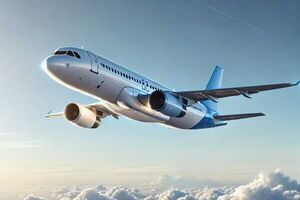- Activities
- Accommodation
- Plane or Boat?
- Traveling to Corsica by Boat
Going to Corsica by Boat
The 5 Maritime Stations of Corsica
The boat crossings from Corsica to the mainland and from the mainland to Corsica are conducted through five commercial ports that crisscross the island (Bastia, Ajaccio, Porto Vecchio, Ile Rousse, Propriano), with destinations to and from the ports of Marseille, Nice, Toulon, and other Mediterranean destinations: Italy (Sardinia, Livorno, Genoa, Savona, Piombino).
Port of Bastia
The port of Bastia has the highest maritime traffic on the island, both passengers and freight. This is partly due to its connections with Italy, which the port of Ajaccio does not have. The Bastia maritime station is located at the northern exit of the city, past the large tunnel.
Port of Ajaccio
The commercial port of Ajaccio is located at the entrance of the city on Quai L'Herminier, after Boulevard Charles Bonaparte, taking the exit towards the quay at the roundabout facing the railway station. For pedestrians, you will need to take the route via Quai L'Herminier, where you cannot miss the imposing maritime station of the city.
Port of Ile Rousse
Access to the commercial port of Ile Rousse is located on the Pietra peninsula, after the city's marina.
Port of Porto-Vecchio
The commercial port is situated in the heart of the Gulf of Porto Vecchio, very close to the marina.
Port of Propriano
The commercial port of Propriano is located on the southern shore of the town's gulf, Quai l'Herminier, behind the Lido beach.
Traveling on a Ferry Company to Corsica - Services and Information
Online Booking

All reservations can be made online on the official websites of the ferry companies, which are available in several languages (see below). You can provide all the information about your crossing and select the desired options.
Your departure and arrival dates, with the choice of departure and destination ports, choice of a day or night crossing, cabin reservation, vehicle boarding, number of passengers, additional consumptions, and other options. An overview of the information is available if you are traveling by ferry for the first time or infrequently.
Day or Night Crossing?
The timing of a daytime or nighttime crossing is strongly correlated with the distance between the departure and arrival ports, although this is not a strict rule.
This is why many crossings between Corsica and certain ports (Toulon, Marseille) will be primarily at night. Some crossings between Nice and Bastia will be either at night or during the day, while crossings between Ile Rousse and Nice will be during the day.
Crossings between Italy and Corsica are mostly during the day, as the Italian coasts are closer than the French coasts. For example, the distance between the port of Bastia and that of Livorno is more than twice as short as that between Bastia and Nice, which is the closest mainland port from Bastia. The port of Piombino is reachable in 3.5 hours of crossing from Bastia.
On the Economic Aspect
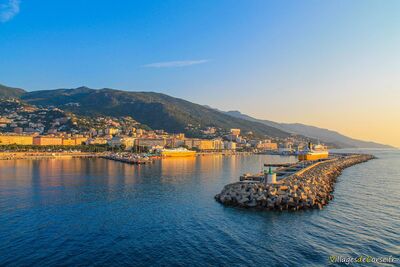
If you have the option to choose the timing of your crossing (day or night), it will depend on your priorities for your trip. It is rare to have the choice of crossing by day or night unless you are willing to change your crossing to a port closer to the island and maintain some flexibility on the dates.
If this is the case, your choice will also depend on the economic benefit. You will need to weigh the pros and cons between traveling more on the road, potentially with highway tolls on one side, but the possibility of avoiding booking a cabin for a day crossing, or departing from a less convenient port that requires a night crossing.
The Crossing Period Affects the Price
In all this, do not forget the price fluctuations related to supply and demand, particularly the day of the week (Saturday being highly demanded), school holiday periods, and public holidays. However, once again, there are no set rules.
Whether to book well in advance to benefit from low prices is another question to consider, given the numerous parameters that determine the rates of the companies. Prices can vary in either direction, so it is important to monitor them well in advance by conducting simulations.
Boarding a Ferry with Your Car
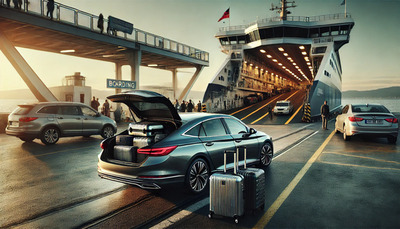
This is the main advantage of choosing maritime travel; boarding with your vehicle allows you to bring more belongings with you.
You can board with all types of vehicles:
- City or family car
- Motorcycle, bicycle, quad
- Camper van, van
The model of your vehicle will be specified in advance when booking online, as the cost will depend on the size of your vehicle, in height, length, and width. You will be guided inside the boat until you are parked (remember to leave the car in gear after turning off the engine). It is important to note or photograph the garage area where you are located, usually indicated by a number and a letter or symbols.
It is important to remember to take all the belongings you will need on board, as the garages will remain closed and inaccessible throughout the crossing.
You can, of course, board as a pedestrian without a vehicle, significantly reducing the cost of your crossing.
Booking a Cabin on Board for the Night
During your booking, each site offers the option to reserve a cabin, useful for spending the night comfortably. The cabin is not mandatory; you can travel without one or opt for other possible arrangements such as a seat, at a much lower cost.
Note that although it may lose its appeal, you can still request to book a cabin for a day crossing if you wish, for less than during a night crossing.
General Features of a Cabin
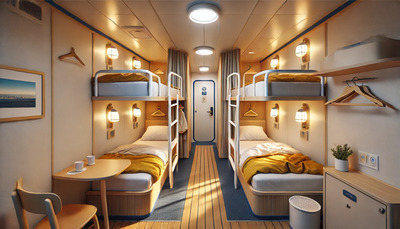
Standard cabins (some companies also offer luxury cabins) are private and secure spaces, numbered, for which you will have keys, a magnetic card, or an access code. The number of your cabin is usually given to you upon boarding. If you have not booked a cabin in advance, you can always go to the reception to check with the receptionist if there are any cabins available.
The cabins are approximately 12 square meters in size, typically consisting of four single beds, two of which are bunk beds, a separate bathroom accessible from within the cabin through a lockable door. The bathroom includes: a shower, a sink, a toilet with toilet paper, soap, and towels (four bath towels often placed on the beds).
They also feature a coat rack, a small table with a mirror, a bedside table with four night lights, two ladders for accessing the bunk beds, and at least one electrical outlet for charging your devices or mobile phone.
Depending on the company, you may find additional amenities such as a hairdryer, water bottles, a television, and an electrical outlet in the bathroom.
The comfort of the cabins and the quality of the amenities largely depend on the ship, its construction date, and the fact that some ships have undergone complete renovations.
Restaurant - Self Service - Bar Lounge - Playroom
On board your ship, you will find various dining options on the different decks, including a self-service or a restaurant open morning, noon, and evening, one or more playrooms for children, as well as a lounge area or bar lounge for relaxation with TV screens.
Note that breakfast and restaurant services can be reserved online when booking your ticket, potentially offering a reduced price depending on the company.
You may also find a cinema area as well as rest rooms with chairs and tables.
A night crossing lasts between 10 and 12 hours, giving you ample time to enjoy the ship by strolling on the different decks, watching the docking or departure of the boat, dining, or resting. It is important to bring something to occupy yourself (book, card games, etc.) to pass the time.
The Main Maritime Companies
The four main maritime companies operating in Corsica (excluding cruises) are Corsica Linea, Corsica Ferry, La Méridionale, and Moby Lines. All these companies offer similar services to different destinations.
Corsica Linea

Corsica Linea is one of the main maritime companies operating between Corsica and mainland France, succeeding SNCM in 2016.
The maritime company serves the ports of Ajaccio, Bastia, Porto-Vecchio, and L'Île-Rousse from or to Marseille:
- In Corsica: Ajaccio, Bastia, Porto-Vecchio, L'Île-Rousse
- On the mainland: Marseille
The Corsica Linea fleet connecting Corsica to the mainland consists of the following ships:
| Ship | Passengers + crew | Vehicles (excluding freight) | To or from Marseille |
|---|---|---|---|
| A Nepita 2002 | 1,200 + 64 | 100 | Ajaccio, Propriano |
| A Galeotta 2022 | 930 + 70 | 150 | Ajaccio, Bastia |
| Vizzavona 1999 | 800 + 50 | 130 | Ajaccio, Bastia |
| Pascal Paoli 2003 | 654 + 42 | 130 | Bastia |
| Paglia Orba 1994 | 592 + 50 | 120 | Ajaccio, Bastia, Propriano |
| Monte d'Oro 1991 | 530 + 43 | 130 | Ile Rousse |
The company also owns other ships such as Méditerranée, Jean Nicoli, and Danielle Casanova, serving North African countries (Algeria and Tunisia).
The official website is at this address: CorsicaLinea.com, and is available in French, English, Corsican, and Italian.
Corsica Ferries

Corsica Ferries was created in 1968, and is another major company operating on the island, offering maritime connections between Corsica and several mainland destinations. With a fleet of large-capacity ships, it transports millions of passengers and vehicles each year.
The main destinations served by Corsica Ferries are Bastia, Ajaccio, Île-Rousse, and Porto-Vecchio in Corsica, as well as Toulon, Nice, Livorno, and Savona in Italy on the mainland. The associated ports include:
- In Corsica: Bastia, Ajaccio, Île-Rousse, Porto-Vecchio
- On the mainland: Toulon, Nice, Savona (Italy)
The Corsica Ferries fleet consists of 10 Mega Express ships built between the 1980s and 2000s, with a capacity of 1,756 to 2,500 passengers and 550 to 770 vehicles.
| Ship | Passengers | Vehicles |
|---|---|---|
| Mega Regina | 2,500 | 700 |
| Mega Victoria | 2,420 | 450 |
| Mega Andrea | 2,000 | 560 |
| Mega Smeralda | 2,000 | 560 |
| Pascal Lota | 2,300 | 665 |
| Mega Express Five | 1,965 | 600 |
| Mega Express Four | 1,880 | 650 |
| Mega Express Three | 2,108 | 670 |
| Mega Express Two | 1,756 | 550 |
| Mega Express | 1,756 | 550 |
| Corsica Marina Seconda | 1,500 | 550 |
| Corsica Express Three | 535 | 150 |
The official website is at this address: Corsica-Ferries.fr, and is available in French, English, German, Corsican, Italian, Dutch, and Spanish.
La Méridionale
La Méridionale is the oldest maritime company, operating since 193. It provides regular connections between Corsica and the mainland, transporting both passengers and goods.
The main destinations of La Méridionale are Ajaccio, Bastia, Ile Rousse, Porto Vecchio, and Propriano in Corsica, with Marseille and Toulon on the mainland, and Livorno. The associated ports are:
- In Corsica: Ajaccio, Bastia, Ile Rousse, Porto-Vecchio, Propriano
- On the mainland: Marseille, Toulon, Livorno
The La Méridionale fleet includes:
| Ship | Capacity | |
|---|---|---|
| Girolata 1994 | 816 passengers | 200 vehicles |
| Kalliste 1993 | 550 passengers | 160 vehicles |
| Piana 2011 | 800 passengers | 200 vehicles |
The official website is at this address: LaMeridionale.fr, and is available in French and English.
Moby Lines
Moby Lines is an Italian company that provides crossings between Corsica and Italy. Founded in 1959, Moby Lines is known for its ships adorned with cartoon characters and whales, and its family-oriented services.
The main destinations served by Moby Lines to and from Corsica are:
- In Corsica: Bastia, Ajaccio, Bonifacio
- On the mainland: Genoa, Livorno, Piombino, Sardinia
The official website is at this address: MobyLines.fr, and is available in French, English, Italian, German, and Dutch.
Sources : Corsica Linea - Wikipedia - Corsica Ferries - LaMeridionale.fr - MobyLines.fr - Corsica-Ferries.fr.Photos générées par intelligence artificielle
